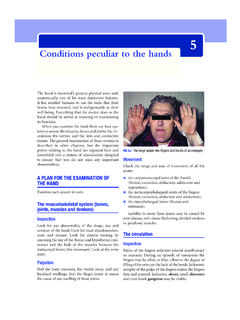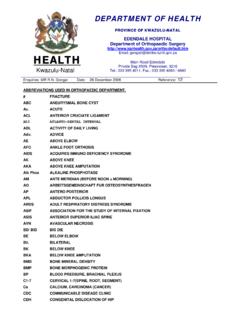Transcription of 178 Ankle block Landmark and Ultrasound …
1 Sign up to receive ATOTW weekly - email Ankle block . Landmark AND Ultrasound technique . ANAESTHESIA TUTORIAL OF THE WEEK 178. 10 TH MAY 2010. Dr. Anthony Allan, Dr. Mark Scarfe Great Western Hospital, Swindon, UK. Correspondence to: QUESTIONS. Before continuing, try to answer the following questions. The answers can be found at the end of the article, together with an explanation. 1. Commencing at a level just proximal to the medial malleolus and moving posteriorly toward the Achilles tendon; What is the correct order of structures? a. tibialis posterior, flexor digitorum longus, posterior tibial artery, tibial nerve, flexor hallucis longus, Achilles tendon b.
2 Flexor hallucis longus, tibialis posterior, flexor digitorum longus, tibial nerve, posterior tibial artery, Achilles tendon c. tibial nerve, anterior tibial artery, tibialis posterior, flexor hallucis longus, flexor digitorum longus, Achilles tendon d. tibialis posterior, flexor hallucis longus, posterior tibial artery, tibial nerve, flexor digitorum longus, Achilles tendon 2. Which of the following statements regarding the saphenous nerve are true? a. always supplies sensation over the medial aspect of the foot b. is a branch of the sciatic nerve c. is difficult to visualise with Ultrasound at the Ankle d.
3 Is best to block first, as it is the largest of the nerves supplying the Ankle 3. The following statements are true regarding Ultrasound guided Ankle a. is performed more proximally on the leg than the Landmark technique b. all the nerves possess helpful vascular landmarks to assist identification c. the tibial nerve should be blocked last because it is the smallest nerve and has the fastest the onset of anaesthesia d. the sural nerve should always be anaesthetised as part of performing an Ankle block , irrespective of the site of surgery ATOTW 178 Ankle block : Landmark and Ultrasound techniques 10/05/2010 Page 1 of 21.
4 Sign up to receive ATOTW weekly - email INTRODUCTION. In this article we describe a technique for blocking the nerves of the foot and Ankle with the assistance of Ultrasound . The block techniques for the 5 nerves supplying the foot are described individually and include Ultrasound images and photographs of the procedure. For completeness, a Landmark Ankle block technique is included at the end of the article. Anatomy Cutaneous innervation The foot is supplied by five nerves, tibial, saphenous, superficial and deep peroneal (fibular) and sural. The diagram below represents the cutaneous innervation of each nerve.
5 It is important to note that whilst this represents normal' anatomical distribution there is considerable variation and overlap of nerve territories between individuals. Tibial Gives off calcaneal, medial and lateral plantar nerves which supply the skin on the sole of the foot and deep structures Saphenous Variable, may not contribute to cutaneous innervation or may supply skin on the medial aspect of foot down to great toe Superficial Peroneal Skin on the dorsum of the foot Deep Peroneal Skin of the 1st web space Sural Skin on the lateral aspect of foot Figure 1.
6 Illustration of the sensory innervation of the foot and Ankle (reproduced with permission from Dr. Alice Roberts). ATOTW 178 Ankle block : Landmark and Ultrasound techniques 10/05/2010 Page 2 of 21. Sign up to receive ATOTW weekly - email General points Exactly which nerves need to be blocked will depend on site of surgery. If surgery avoids the 1st and 2nd toes/metatarsals then a block of the saphenous or deep fibular nerve is not required. Likewise, if surgery does not involve 5th metatarsal/toe then blocking the sural nerve may not be necessary. However, its cutaneous innervation can spread more medially to involve 3rd-5th toes and consideration to this should be given when choosing whether to block it or not.
7 Under Ultrasound the nerves are blocked more proximally than using a traditional technique because: Bony prominence around Ankle makes good skin contact difficult Pressure over bone obliterates vascular landmarks The achilles tendon is avoided when performing an in-plane' approach to tibial nerve When visualising a static Ultrasound image it can be difficult to define the exact margins of these small nerves. If you scan up and down the limb and observe the nerve moving in relation to the other structures it will help you demarcate the nerve boundaries more easily.
8 Equipment Short bevelled block needle (50mm)*. US machine with high frequency linear probe Local anaesthetic 2% aqueous chlorhexidine (or equivalent). Sterile drapes/gloves/probe cover/ Ultrasound gel Ankle tourniquet * Once confident with sono-anatomy and needle visualization using a 27 gauge needle attached to an extension avoids having to use local infiltration before needle insertion. It is more comfortable for the patient but may increase the risk of intraneural needle placement as it is more difficult to visualize and will penetrate a nerve more easily than a short beveled needle.
9 In addition the increased resistance to injection from the narrow bore needle may mask an indicator of intraneural injection. This technique should be reserved for those who already have considerable experience with Ultrasound guided regional anaesthesia and are familiar with the Ankle sonoanatomy. Remember to use an Ankle tourniquet in an awake patient. ATOTW 178 Ankle block : Landmark and Ultrasound techniques 10/05/2010 Page 3 of 21. Sign up to receive ATOTW weekly - email General technique If needling with right hand stand, stand on the left-hand side of the patient, all nerves on both legs are accessible from this position so it avoids moving the equipment around the room.
10 Position the patient supine with leg to be blocked crossed over the knee in a figure 4'. position. Aim for the Ultrasound machine, probe/needle/patient and operator to be in-line (photo 1). All injections are described as an in-plane technique . Always start with the tibial nerve, it is the largest nerve and therefore takes the longest for the block to develop (up to 20 minutes). Position your needle initially deep to the nerve in the 6 o'clock position, inject, if spread is not circumferential then reposition your needle to the 12 o'clock position. Inject up to 2ml of LA around each nerve (except for the tibial nerve where up to 5ml may be required for good perineural spread).













